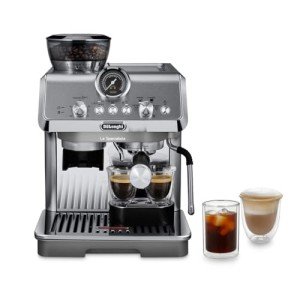13 Things About Italian Espresso Machines You May Not Have Considered

Heat Exchange Espresso Machines: A Comprehensive Guide
Espresso machines have evolved substantially for many years, accommodating the needs of home baristas and coffee professionals alike. Among these machines, heat exchange espresso machines have actually acquired popularity due to their ability to deliver consistent efficiency and remarkable brew quality. In this article, we will explore the operations, advantages, and important functions of heat exchange espresso machines, offering a comprehensive understanding for both prospective buyers and coffee enthusiasts.
Comprehending Heat Exchange Technology
Heat exchange espresso machines run on a distinct principle that allows simultaneous water heating for brewing and steaming. visit the up coming article are geared up with a single boiler that uses a heat exchanger system. This feature is significant as it enables users to brew espresso while steaming milk simultaneously, promoting efficiency in the coffee-making procedure.
How Does a Heat Exchange Espresso Machine Work?
The procedure starts with the machine's water inlet filling the boiler. As the water warms up, it turns to steam. Espresso Machines With Grinder uses hot steam to heat extra water in a separate passage designed specifically for the brew group. This implies that water can reach the perfect developing temperature level without awaiting the boiler to adjust. The key steps include:
- Water Fill: Water is drawn into the boiler.
- Heating Process: The boiler warms up as water is converted into steam.
- Heat Exchange: Steam heats up water in the heat exchanger tube.
- Developing: Water from the heat exchanger is pushed through coffee premises, extracting the tastes needed for a rich espresso.
This procedure allows for fast temperature changes and enhanced coffee extraction.
Advantages of Heat Exchange Espresso Machines
Heat exchange espresso machines offer numerous advantages, particularly for those aiming to optimize their coffee experience. Here are some crucial benefits:
- Simultaneous Brewing and Steaming: Users can brew espresso while steaming milk, making it perfect for hectic coffee shops and home baristas who value effectiveness.
- Temperature Stability: The boiler's steam pressure assists keep a stable temperature, which is critical for consistent espresso extraction.
- Flexibility: The design enables quick switching in between brewing and steaming, making it easier to create different coffee beverages, from lattes to cappuccinos.
- Easy to use: Models frequently include accessible controls, making it feasible for both newbies and skilled baristas to produce quality beverages.
- Professional Quality: Heat exchange machines are often utilized in commercial settings, providing users with high-quality developing performance in the house.
Secret Features to Look for in Heat Exchange Espresso Machines
When considering the purchase of a heat exchange espresso machine, there are several features that a person must take into consideration:
- Build Quality: Look for machines made from long lasting products, such as stainless steel or brass, ensuring longevity.
- Boiler Size: A larger boiler will hold more water and sustain higher output in time.
- PID Temperature Control: This function helps keep consistent brew temperature levels, which can improve the coffee-making process.
- Group Head Design: Machines with a saturated or semi-saturated group head offer better temperature level stability.
- Alleviate of Use: User-friendly interfaces and user-friendly controls enhance the overall experience for baristas at all skill levels.
- Steam Wand Quality: A good steam wand with correct insulation and versatility permits better texturing of milk.
- Water Reservoir Size: Depending on your needs, consider how often you wish to fill up the water tank.
Comparison of Popular Heat Exchange Espresso Machines
To much better understand the alternatives offered in the market, listed below is a contrast table of some popular heat exchange espresso machines:
| Machine Model | Boiler Size | PID Control | Rate Range | User Ratings |
|---|---|---|---|---|
| Profitec Pro 700 | 2.0 L | Yes | ₤ 2,000-₤ 2,500 | 9.5/ 10 |
| Rocket Espresso R58 | 1.8 L | Yes | ₤ 2,400-₤ 2,800 | 9.4/ 10 |
| Elekta Bianca | 1.8 L | Yes | ₤ 2,500-₤ 3,000 | 9.6/ 10 |
| La Spaziale S1 Vivaldi II | 1.5 L | Yes | ₤ 1,800-₤ 2,200 | 9.2/ 10 |
| Bezzera Magica | 1.2 L | No | ₤ 1,600-₤ 1,800 | 9.0/ 10 |
FAQs About Heat Exchange Espresso Machines
What is the primary distinction between a heat exchange and a dual boiler espresso machine?
While both types can brew espresso and steam milk at the exact same time, dual boiler machines have separate boilers for brewing and steaming. On the other hand, heat exchange machines utilize a single boiler and a heat exchanger to achieve the same function.
Are heat exchange machines appropriate for beginners?
Yes! Lots of heat exchange machines are created with easy to use functions, making them available for newbies. With correct guidance and practice, users can rapidly produce quality espresso.
What sort of maintenance do heat exchange espresso machines need?
Routine maintenance includes descaling, cleaning up the boiler, examining seals and gaskets, and keeping the group head tidy. Regular upkeep guarantees durability and consistent performance.
Can I use a heat exchange machine for various types of coffee beverages?
Absolutely! Heat exchange machines allow users to develop a range of coffee beverages, consisting of espresso, lattes, cappuccinos, and more.
Heat exchange espresso machines represent a mix of innovation and custom, offering coffee lovers with the tools required for crafting the best cup. Their ability to all at once brew and steam, integrated with accurate temperature level control, makes them a compelling option for both home baristas and experts. With the best understanding on functions and maintenance, users can unlock a world of charming coffee experiences, guaranteeing that each sip is as wonderful as the last.

